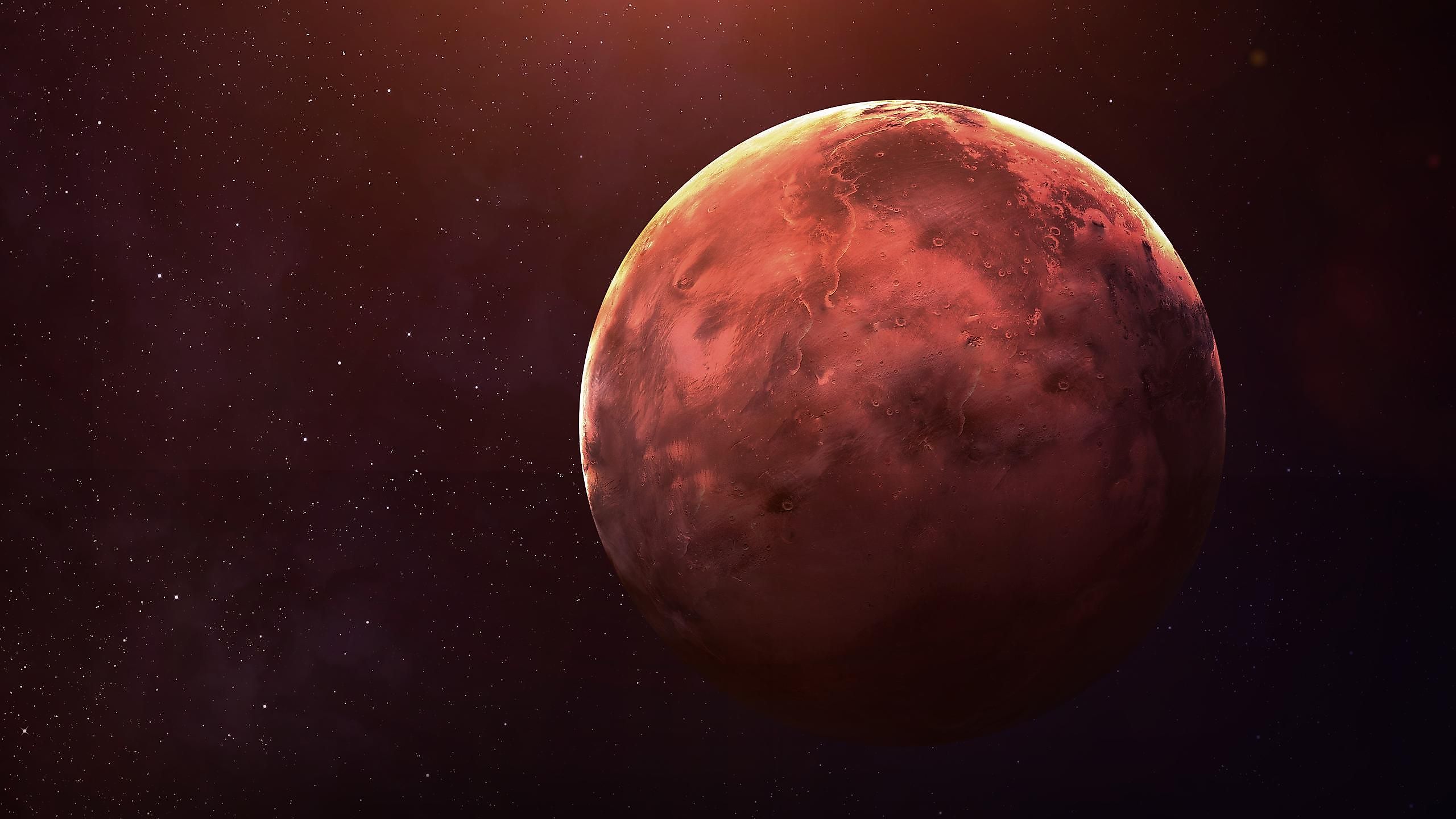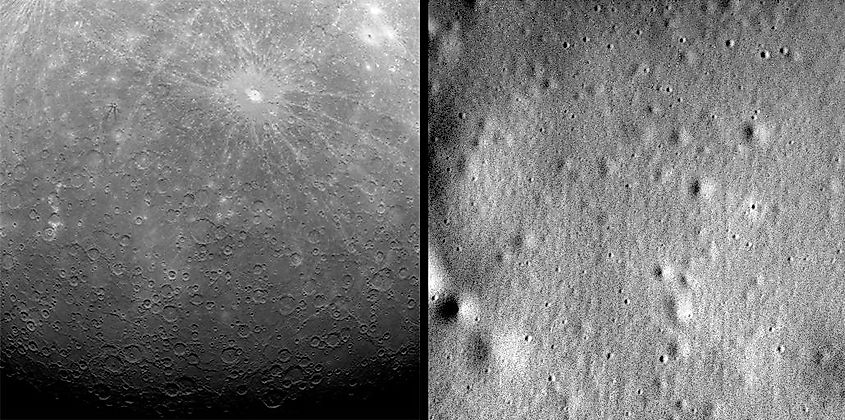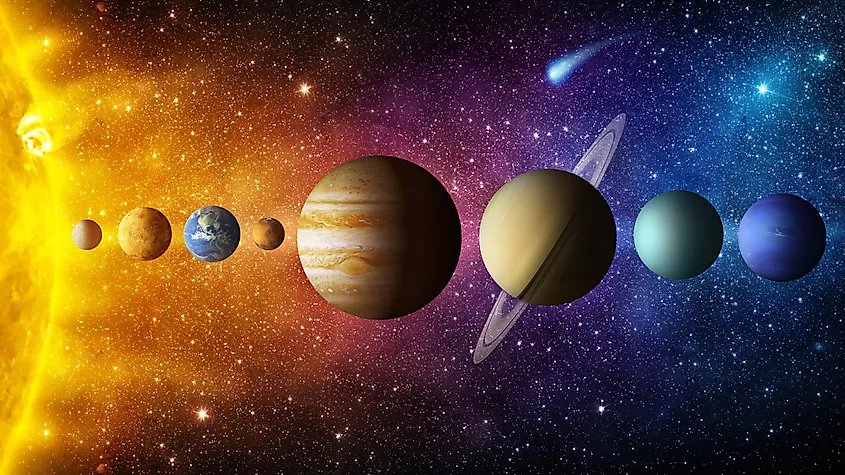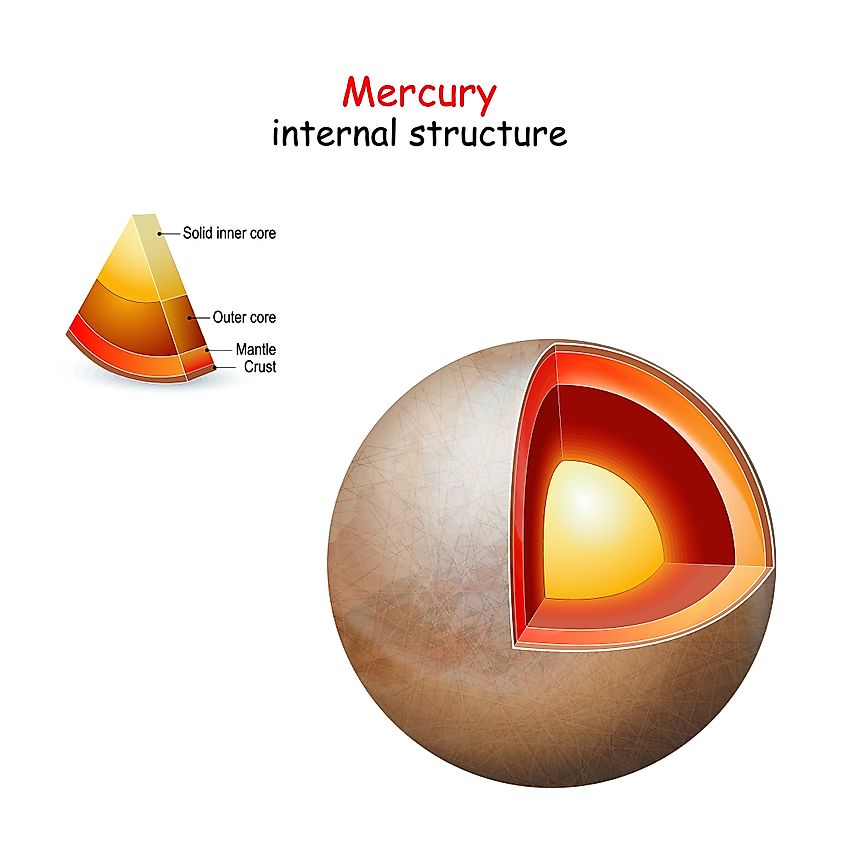
Mercury
Mercury is the closest planet to the Sun in our solar system. Mercury is the smallest planet in the solar system with a diameter of 3,032 miles, only 435 miles larger than Earth’s moon. Mercury is a rocky world with an iron core and a rocky crust. Since Mercury is visible without needing any kind of equipment, its existence has been known since ancient times, with the earliest recorded observations of Mercury dating back to the Sumerian civilization of ancient Mesopotamia. Since Mercury is the closest planet to the Sun, it is one of the most difficult planets to see with the naked eye. In fact, Mercury is never visible at night, but rather, is visible in the very early evening just as the Sun is setting. Like every other planet in the solar system, Mercury gets its name from Roman mythology. In the case of Mercury, it is named after the Roman god of commerce and messages. In Roman mythology, Mercury was the messenger of the gods. Due to the planet Mercury being located so close to the Sun, it appeared as though it was chasing the Sun at high speeds, and so the Greeks and Romans viewed Mercury as a messenger that moved swiftly. In fact, the Greek equivalent to Mercury was Hermes, the messenger of the gods who often travelled between the realm of the gods and mortals at high speeds.
Historical Observations Of Mercury

Ancient civilizations often viewed the planets as deities or related to a god in some form. This was the general belief until the invention of the telescope. In the 1600s, the astronomer Galileo Galilei became the first human being to observe Mercury through a telescope. Unfortunately, Galileo’s telescope was not strong enough to make out any specific details of Mercury, and so Galileo discovered very little about Mercury. Since Mercury orbits so close to the Sun, it is one of the most difficult planets to observe with a telescope. It wasn’t until the 1800s that telescopes became advanced enough that astronomers could actually start observing Mercury in detail and make out surface features. In 1800, the astronomer Johann Schroter observed surface features on Mercury, claiming to have seen large mountains on the planet’s surface. Decades later in the 1880s, another astronomer by the name of Giovanni Schiaparelli made the most detailed observations of Mercury’s surface and estimated that Mercury had a rotational and orbital period of 88 Earth days. When a planet has a rotational and orbital period that are identical, it is called synchronous rotation. The belief that Mercury had synchronous rotation persisted in the astronomical community until the 1960s, when the Soviet Union began the first ever radar observations of Mercury. Soviet scientists bounced radar signals off Mercury’s surface to not only map the planet, but to also measure how fast the planet was rotating. The data suggested that Mercury had a rotational period of 59 Earth days, a discovery that astronomers were reluctant to accept. In 1965, American scientists attempted to replicate the observations done in the Soviet Union and confirmed that Mercury’s rotational period was 59 Earth days.
Missions To Mercury
Since Mercury is the closest planet to the Sun, it experiences the most extreme gravitational effects of the Sun. The result is that Mercury is the fastest planet in the solar system, moving around the Sun at a speed of 29.5 miles per second (47.4 km/s). At this speed, it is tremendously difficult to launch a spacecraft that can adjust its velocity to enter orbit around Mercury. Fortunately, NASA scientists figured out a way to do this by having a spacecraft use the gravity of the planet Venus to adjust the spacecraft’s velocity and eventually enter into orbit around Mercury. In 1973, NASA launched the Mariner 10 spacecraft in what would become the first ever mission to approach the planet Mercury. Mariner 10 reached Mercury in 1975. Mariner 10 provided scientists with the first ever close-up images of Mercury’s surface. Mariner 10 also attempted to create the first ever global map of Mercury, yet unfortunately, during the entirety of its mission, only one side of Mercury was facing the Sun, and so Mariner 10 was only able to map roughly 45% of Mercury’s surface. In addition to the first images of Mercury’s surface, Mariner 10 confirmed the existence of a magnetic field around Mercury, a discovery that astronomers had originally thought impossible given Mercury’s slow rotation and small size.
Mariner 10 was the first spacecraft to visit Mercury, and due to the difficulty of sending a spacecraft to Mercury, scientists would not send another until 2004 with NASA’s MESSENGER (Mercury Surface, Space Environment, Geochemistry, and Ranging) spacecraft. MESSENGER launched on August 3, 2004 and took over six years to reach Mercury. Unlike Mariner 10, scientists planned on having MESSENGER enter into orbit around Mercury. To do this, scientists had MESSENGER flyby the Earth, Venus, and Mercury several times in order to adjust the speed of the spacecraft so it could enter into a stable orbit. On March 18, 2011, MESSENGER became the first spacecraft in history to enter into orbit around Mercury. MESSENGER has provided scientists with an unprecedented amount of data on Mercury. Most of what is known about Mercury comes from this mission. MESSENGER remained in orbit collecting data until April 30, 2015 when it crashed into the surface of Mercury. MESSENGER was able to map 100% of Mercury’s surface and provided scientists with over 100,000 images of Mercury.
As of yet, Mariner 10 and MESSENGER have been the only missions to Mercury. However, a new spacecraft, called BepiColombo, is currently on its way to Mercury. BepiColombo is a joint venture between the European Space Agency (ESA) and Japanese Aerospace Exploration Agency (JAXA). BepiColombo will include two satellites designed to study the surface of Mercury and its magnetic field. The mission, launched on October 30, 2018, will arrive at Mercury in December 2025.
How Far Is Mercury From The Sun?

Mercury is the closest planet to the Sun at a distance of 36 million miles (58 million kilometres). At such a close distance, Mercury experiences some of the highest temperatures in the solar system. Surface temperatures on Mercury can reach as high as 806 degrees Fahrenheit (430 degrees Celsius) during the day. However, Mercury lacks a significant atmosphere, and so there is nothing to help regulate and distribute heat across the planet’s surface. As a result, Mercury experiences extreme changes in temperature depending on the amount of sunlight. During the day, temperatures are extremely high, yet at night, temperatures can plunge to -292 degrees Fahrenheit (-145 degrees Celsius). Interestingly, Mercury has no significant axis tilt, and so unlike some other planets, Mercury experiences no seasons. Furthermore, since Mercury has no tilt, regions in the North and South poles exist in perpetual darkness, never once seeing sunlight. Interestingly, scientists have actually uncovered large deposits of water ice at Mercury’s poles. You would think that on such a hot planet, water would be on-existent, yet due to the cold temperatures at the eternally dark poles, ice can actually exist.
Size, Mass, Composition, And Density Of Mercury

Mercury is the smallest planet in the solar system at 3,031 miles in diameter (4,878 km) and it is also the smallest planet by mass. In comparison to the Earth, Mercury’s mass is only 0.055% that of Earth’s. Interestingly, despite its small size and low mass, Mercury is actually the second densest planet in the solar system after Earth. Although it may sound strange that Mercury is one of the densest planets in the solar system, it is important to note that density is simply a measure of how much material there is in a measured region. A planet can be small and not very massive but still have a very high density. In the case of Mercury, its density stems from its composition, most notably the core of Mercury. Mercury contains an abundance of heavy metals, with its core being made mostly of iron. Mercury’s iron core comprises about 75% of the planet’s total mass, with the remaining 25% being silicate rock. In comparison to the other rocky worlds in the inner solar system, Mercury has a gigantic iron core. The reasons for this likely have to do with where Mercury formed. Mercury formed closer to the Sun than other planet, and thus the Sun’s magnetic field was stronger for Mercury than it was for the other planets during their formation. The Sun’s magnetic field would have attracted an abundance of heavy metals such as iron, causing them to accumulate closer to the Sun’s surface.
Does Mercury Have An Atmosphere?
Although Mercury’s atmosphere is negligible, it still technically has one. However, given its size and composition, it is not referred to as an atmosphere. Rather, Mercury has what’s called an exosphere. Since Mercury is so small and has such a low mass, it’s difficult for the planet to hold onto an atmosphere. Over many millions of years, any atmosphere would slowly dissipate into the surrounding space. However, even if Mercury were massive enough to hold onto an atmosphere, its position in the solar system isn’t very ideal for an atmosphere. Extreme radiation from the sun, called the solar wind, would quickly strip away any atmosphere that formed around Mercury. Mercury’s exosphere is likely the result of the solar wind’s interaction with materials on the surface. The exosphere itself is composed mostly of magnesium, silicon, and calcium. When the solar wind interacts with these chemicals, it knocks them off the surface and into Mercury’s exosphere. The solar wind may be one of the biggest factors as to why Mercury does not have an atmosphere, yet it also creates what little atmosphere Mercury has.
How And When Did Mercury Form?
All of the planets in our solar system formed at roughly the same time 4.5 billion years ago and in a similar manner. All of the planets formed from a large disk of stellar material that formed shortly after the Sun formed. This large disk is called a protoplanetary disk, and they are the birthplace of planets. Over many millions of years, dust particles in the protoplanetary disk accumulate to form larger objects. As objects grow in size and mass, their gravitational pull becomes stronger, allowing them to bring in and accumulate more material. The process of matter accumulation becomes exponential, until it eventually forms an entire planet. When the Sun first formed, the energy it produced would have caused the distribution between light elements and heavy elements to be different across the solar system. The inner solar system contained a much inherent abundance of heavy metals and rock, while the outer solar system would have contained a high abundance of lighter materials such as hydrogen and helium. It’s this distribution in the early solar system that explains why Mercury contains such a high abundance of heavy metals and silicate rock. Interestingly, when the planets first formed, there were likely far more of them than the eight we are familiar with. Some planets formed relatively close to one another, and collisions between planets were common in the early solar system. Mercury itself was likely the victim of a planetary collision. Relative to the other rocky worlds, Mercury’s has an extremely large iron core surrounded by a thin shell of rock. It’s possible that Mercury collided with another planet that stripped Mercury of its outer materials.
The Geologic History Of Mercury
At first glance, Mercury looks pretty similar to the Earth’s moon. Its grey surface is battered in impact craters, many of which date back to the very formation of the solar system itself. The existence of extensive and ancient craters across the surface suggests that Mercury has not been geologically active for billions of years. Generally, the more craters a world has and the older they are is a strong indication of a lack of any recent geologic activity. Geologic activity is powered by a planet’s internal heat. Smaller worlds with a weak gravitational pull will have a hard time holding onto their internal heat, and in the case of Mercury, it likely lost most of its internal heat billions of years ago. However, shortly after Mercury’s formation, it was in fact geologically active. The surface of Mercury is covered in volcanic rocks and minerals, suggesting that Mercury has experienced large-scale volcanism in its past. The majority of Mercury’s impact craters formed during a period of time called The Late Heavy Bombardment, a period of intense collisions between the planets and planetary debris that lasted from 4.1 to 3.8 billion years ago. During this time, Mercury was bombarded by thousands of asteroids and meteors. Furthermore, Mercury was volcanically active during The Late Heavy Bombardment. Volcanic magma from Mercury’s interior erupted to the surface and filled in some of the newly formed craters. Once Mercury began to cool, the magma solidified and formed vast, smooth plains across Mercury’s surface.
Significant Events
- 4.5 billion years ago: Mercury forms in orbit around the Sun
- 4.1 to 3.8 billion years ago: The Late Heavy Bombardment results in the formation of craters across Mercury’s surface
- 5,000 years ago: The Sumerian civilization in Mesopotamia makes the first recorded observations of Mercury in human history
- 1610: Galileo Galilei becomes the first human to observe Mercury through a telescope
- 1631: Astronomer Pierre Gassendi observes Mercury pass in front of the sun in the first ever observed transit of Mercury
- 1639: Astronomer Giovanni Zuni observes Mercury through a telescope and discovers the planet has phases, confirming that Mercury orbits the Sun.
- 1800: Johann Schroter confirms the existence of surface features on Mercury
- 1880: Giovanni Schiaparelli measures the length of a year on Mercury to be 88 Earth days
- 1934: Astronomer Eugenios Antoniadi provides the first detailed maps of Mercury’s surface
- 1962: The Soviet Union uses radar to determine Mercury’s rotational speed and map the surface
- 1973 to 1975: NASA’s Mariner 10 spacecraft becomes the first spacecraft to study Mercury up close
- 2004: NASA’s MESSENGER spacecraft launches from Earth towards Mercury
- 2011: MESSENGER enters into orbit around Mercury
- 2018: The European Space Agency and the Japanese Space Agency launch BepiColombo, a pair of satellites that will enter Mercury’s orbit in 2025
| Diameter | 3,032 miles (4,878 km) |
|---|---|
|
Mass |
3.285 x 10^23 kg (0.055 Earths) |
|
Moons |
Zero |
|
Distance from the Sun |
36 million miles (58 million km) |
|
Length of Year |
88 Earth days |
|
Length of Day |
59 Earth days |
|
Surface Temperature |
800 degrees Fahrenheit (426 degrees Celsius) |
|
Atmospheric Composition |
Helium, Argon, Sodium, Potassium |
|
Surface Composition |
Large iron core, silicate crust and mantle |
|
Surface Gravity |
0.38 Earths |
|
Weight of 180 pound person on the surface |
68 pounds |
|
Discovery Date |
Over 5,000 years ago |
|
Discovered By |
Earliest written records of observation come from the Sumerian civilization |











